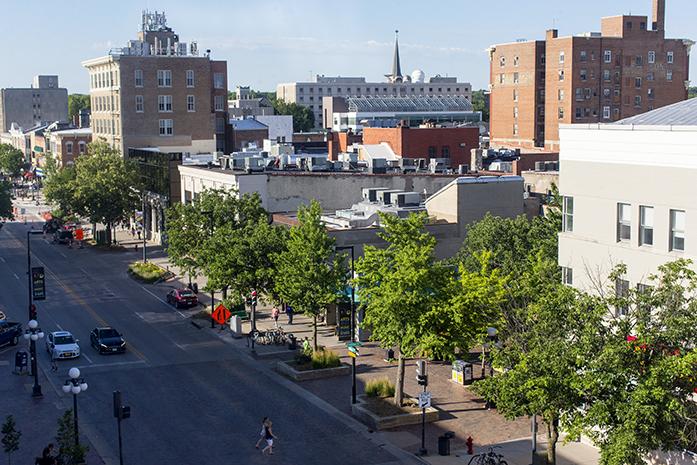Banerjee: ‘Urban progress’ and other euphemisms
The evolving face of Iowa City’s downtown spells out progress for much of the city’s economic prospects, but is it what’s best for a city whose problems are deeply internal problems which still need to be addressed?
Pedestrians cross Clinton Street and enter the Pedestrian Mall in Downtown Iowa City on Monday, June 27, 2016.
September 17, 2018
For the students of the University of Iowa, the downtown landscape quickly becomes a second home after arriving on campus. Even first-year students see navigating the various boutiques, coffee shops, and restaurants as nearly a second nature by this point in the semester.
Yet, the downtown we see now has steadily changed radically over the past few decades, and it and near downtown continue to grow as more large-scale construction projects, such as the Rise and Chauncey, take place. With the changing landscape, the need for “urban progress” has pushed beyond some of the community’s most pressing needs.
Iowa City, and especially the Downtown District, has gone through a number of evolutions over time. Beginning as a small plotted town slated to become the new capital in the 1830s, its nearly 200 years of history have taken Iowa City through many paths and purposes, ranging from state capital to college town.
RELATED: Inside the Rise: What these new apartments offer Iowa City’s students
It’s difficult to not notice the growing gentrification downtown. The area’s finest qualities — pleasing aesthetics, community-centric spaces, and modern architecture — mask larger inequalities. Prices for food, shopping, and entertainment often land outside the budget of the average inhabitant, and while there seems to be a large (and ever increasing) number of charming coffee shops, the city’s homeless still remind us of Iowa City’s affordable-housing drought.
Construction has played a large role in changing downtown. Luxury apartments are being built at impressive speeds; recent rezoning projects and proposals, such as the Pentacrest Garden project, indicate this trend will continue. Yet, despite all the new buildings littering the face of downtown, the city still has a poverty rate of 28 percent, according to a 2012-16 U.S. Census Bureau study.
While good for “urban progress,” these new buildings are causing a great strain on the affordable-housing crisis in Iowa City. The new buildings that are created will most likely lead to rent hikes in the surrounding areas as the value of land continually goes up. Not to mention, these luxury buildings are entirely unaffordable to the population of Iowa City that needs housing the most.
RELATED: Pentacrest Garden developers push for additional height on their buildings
Currently, the city is expanding at its fastest rate since the 1970s, according to the most recent U.S. Census estimates. The expansion rate, which is nearing 2 percent as of last year, is a crucial factor in the changing landscape. The influx of people has led to an “urban renewal” effort by the city, aimed at bringing a more affluent demographic into the heart of downtown.
Appealing to the shifting demographics of Iowa City has its purposes; the money that comes from the increasingly wealthy populace is vital to the continued growth and progress of the city. Its economic benefits can be a true boon to the town, allowing it to grow and expand. Business owners have already seen benefits from the changing downtown scene.
Brothers general manager Michael Lawler feels that the construction had a distinctly positive effect. “If anything, it’s updating downtown and bringing more business,” he said.
RELATED: Iowa regents OK proposal for UI’s new innovation center
Gentrification plays a double-sided role in revitalizing a city. It can certainly, at least outwardly, positively affect the way an area functions, but its progress is contingent on brushing aside more important civic issues. The construction of luxury apartments, and the recent zoning for them, does not bode well for the future of Iowa City. At the end of the day, expansion matters less than the preservation of the people who have called Iowa City home for decades, especially those who are at risk. It’s up to the city and its developers to decide what to do about the issues we already face before we continue to expand beyond our purview.





